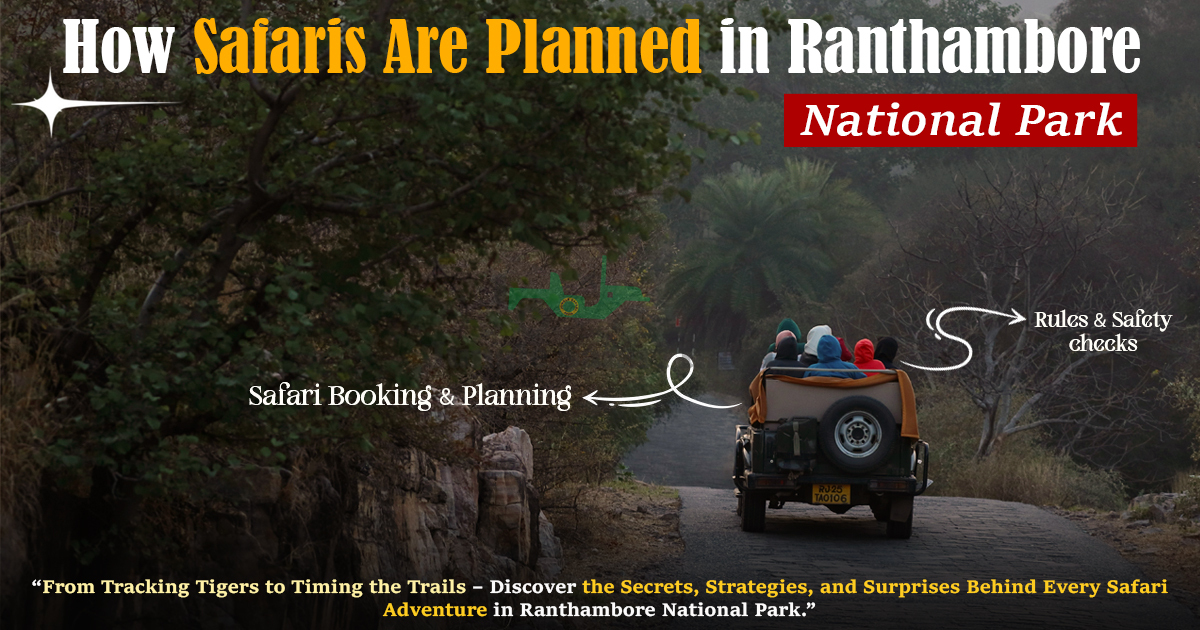Whenever people think of the Ranthambore National Park, a thrilling safari ride inside the forest comes to their mind. They suddenly think about clicking pictures of animals, the thrill of spotting animals, and spending a peaceful safari time. But there are things that people don’t realize, such as the careful planning, rules, and teamwork that go behind the scenes to make the ride interesting for tourists.
From the moment people click “make a booking” online till the time their safari really happens and it enters the gate, the forest department and staff handle a lot of work behind the scenes. Let’s know how safaris are planned in Ranthambore to provide guests with a memorable experience.
1. Safari Booking & Planning
The forest department allows people to make a booking online. This is the first step, and it is highly important to protect the forests and wildlife. Before even the start of the ride, the system already begins shaping your safari experience. The forest department of Rajasthan allows tourists to make Ranthambore online safari bookings in advance. People can make the bookings by entering details like name, age, nationality, ID proof details, and others.
This park is not like other tourist destinations where unlimited entry is allowed. The National Parks are not like that. These are protected areas and a natural home of animals, and because of that, the forest department allows only a limited number of safaris inside Ranthambore National Park each day. They allow only a particular number of gypsies (6-seaters) and canters (20-seaters) to enter the park. The forest department decides on this rule to avoid disturbing the wildlife.
People can choose their preferred safari zone in Ranthambore, but the park authorities do not guarantee that they will give you the exact zone you want. The computer randomly assigns the zone in Ranthambore (from 1 to 10) to make sure that equal safaris are going inside the park in each zone, and it avoids overcrowding in particular zones.
2. Dividing the Park into Safari Zones
The Forest Department of Ranthambore has divided the park into 10 safari zones. The forest department has divided each safari zone in Ranthambore by keeping in mind the area, landscape, water bodies, tiger territories, and many more. Each zone has its own beauty and offers a unique experience to tourists. Diving on the basis of tiger territories ensures that the forest department is giving animals their own space, and people can enjoy the safaris without disturbing the natural habitat of animals.
Some zones may be more famous for tiger sightings, but every zone has its own charm, so no matter which zone you get for the safari, be ready to enjoy an exciting time inside the park. Enjoy the natural beauty and thrilling vibes of this amazing spot. The forest department has divided the zone so that forest guards and naturalists can easily track the animals and monitor the wildlife of the park. This also allows them to reach the specific areas of the park without any confusion. So, the idea of zones is not random, and it is a carefully thought-out plan that balances the tourism and safety of both visitors and animals inside the park.
3. Guides and Drivers Training
Whenever people go on a safari in Ranthambore, the guides and drivers go with them. The government does not allow people to go inside the park on their own. You have to take a forest guide and a driver to go inside. The forest department checks the vehicles and assigns them to drivers. The drivers know the routes, understand the tricky tracks, and receive training from the department on how to drive gypsies and canters in the park. They also know about the speed limit of gypsy and a canter.
Furthermore, the forest department also trains the guides and allocates them to gypsy safaris through a roster system. They know everything about the park related to its flora, fauna, animal spotting areas, temperature, water bodies, etc. They can even read the pugmarks, know the warning calls of animals, and depict where they can be seen. The coordination between guides and drivers makes the safari enjoyable for everyone. The driver takes care of the gypsy route and driving limit, and the guides help in spotting animals.
4. Scheduling Safaris
Another important part of safari planning is time. The park runs safaris twice a day. You can make a Ranthambore online safari booking for a morning or evening ride. This ride usually takes place for 2 to 3 hours and allows people to spot animals when they are more active. The timings are not fixed year-round. Timings of the safari inside Ranthambore can change according to sunrise and sunset, and it’s not safe to go inside the Jungle in the darkness. The forest department decides safari slot timings after observing when animals are more active, so that guests can enjoy their experience.
The safari timings are flexible and they allow people to see the maximum number of animals, as they can be spotted easily in the early morning and evening. These are the times when animals are most active, moving around in search of food, water, or interacting with their surroundings. The forest department has planned a safari at this time to give guests a better chance to spot the wildlife.
5. Rules & Safety Checks
The safaris inside the Ranthambore are not just about providing a great experience to the tourists. They are carefully regulated so that the wildlife of the park and the flora remain safe. There are particular rules, like no one can go inside without providing their IDs. This rule ensures that only authorized visitors enter the park and prevents overcrowding or misuse of safari slots. Also, the rule about the carrying capacity of vehicles makes sure that everyone remains safe and that overcrowding is avoided. No loud noises, no getting out of the vehicle, no littering, and no feeding animals. Following these rules protects wildlife from disturbance, and also, because of them, humans remain safe.
These behind-the-scenes checks may look strict, but they are the reason Ranthambore continues to be one of the most famous Indian national Parks to provide safaris. By following some basic rules of the park, you can keep the natural habitat safe for animals and also avoid any mishappenings and accidents inside the Jungle. All in all, these rules are important to keep the animals and tourists safe and secure inside the boundaries of the park.
Conclusion
Planning a safari in Ranthambore is much more than just giving a good experience for guests. Every detail of the safari is carefully planned to protect the wildlife and also provide a good experience to the guests. The forest department, guides, and drivers work together to make sure that the safari experience becomes exciting for everyone. Next time, whenever you go for a safari, keep in mind that it’s not a simple ride. The safari is actually the result of careful planning, teamwork, and the efforts of the forest department.





